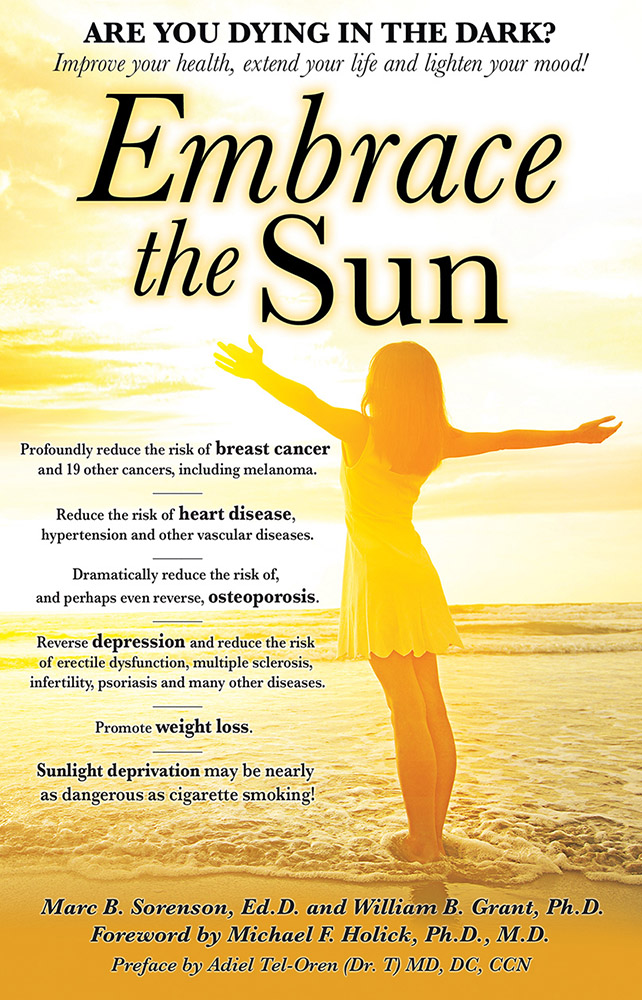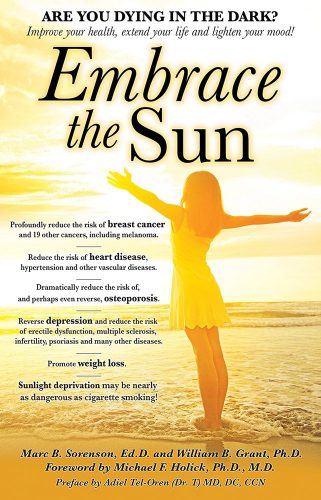Childhood diseases prevented by Sunlight. by Marc Sorenson, EdD
Childhood diseases are directly associated with sun deprivation: Therefore, childhood death and disability can be due to lack of sun exposure!

Childhood diseases and disorders that are prevented by sun exposure have been discussed on many of my recent blogs. Our children are becoming ill due to our neglect. We must insist that they (or in some cases their mothers) play outside each day while eschewing their electronic devices. So, let’s now discuss a few more childhood diseases that are associate with sun deprivation. First of all, there is a 61% increase in death risk among children born to women with low 25(OH) D levels. Since sun exposure on skin is the main source of that photoproduct (vitamin D), the mothers lack sufficient sun exposure. Therefore, they do not furnish the necessary vitamin D to deliver a healthy baby. Furthermore, they are unlikely to bring their babies out in the sun after birth.
It is probably important at this point to mention a vital point. In many cases, vitamin D is exceptionally important. And in other cases, vitamin D may have little to do with the childhood diseases being considered. Since sun exposure leads to vitamin D production, vitamin D levels may simply be a surrogate measurement for sun exposure. Therefore, it may be other photoproducts of sun exposure that are creating some of the health benefits. And what are some of those other photoproducts that may reduce childhood diseases?
- Serotonin, which is one of the body’s natural “uppers”
- Endorphin, another feel-good hormone
- Dopamine, which affects learning and behavior and may help schizophrenia, to attention disorders, and cognitive reasoning
- Brain-derived neurotropic factor (BDNF), which is essential for nerve growth
- Nitric oxide, which reduces blood pressure and may help prevent heart disease.
Whenever vitamin D deficiency is blamed for childhood diseases, sun-exposure deficiency—which causes vitamin D deficiency—is the actual culprit.
Here are three more childhood diseases that are associated with low sunlight exposure:
Eczema: a disease that can be a part of childhood diseases
First of all, a study of children aged 0-17 years showed sun exposure was associated with lessened prevalence of eczema. Hence, children in the highest fourth of exposure were 20% less likely to experience eczema. This is one of the common childhood diseases.
Lack of bone mineralization and size: another of the childhood diseases.
An English investigation, involving 7,000 children, found bone size was positively related to sun exposure of mothers during pregnancies. Researchers conducted another study on children with on poor bone mineral density that predicted fractures. All of them had a significant increase in bone density because of a sun-exposure program that lasted a year. It is also most noteworthy that none of these children had a fracture after the start of the sun-exposure program.
Food allergy emergency: Another of the childhood diseases
Research from Boston states that children younger than 5 years, who were born in fall or winter (times of low sun exposure) had bad outcomes. They had about 50% increase in the risk of emergency room visits for food allergies. That is, compared with children born in spring or summer. Hence, the authors suggested this finding was related to differences in UVB (sun) exposure during their mother’s pregnancies.
In subsequent blogs we will discuss more childhood diseases that are triggered by sun deprivation. In the meantime find more information at sunlightinstitute.org and read the book, Embrace the Sun.
Happy sunning!

Obesity in children: Caused by pregnant mom’s sun deprivation? By Marc Sorenson, EdD. 
Obesity in children is linked closely to maternal vitamin D status in pregnancy.[1] And is anyone surprised about this? First of all, everyone should know that vitamin D deficiency is caused by inadequate sun exposure. So, if high vitamin D is associated with less weight, it is because of high sun exposure. That is of course, unless the research involves vitamin D supplementation. Because sunlight produces nitric oxide, endorphin, serotonin, dopamine and other chemicals, only research can determine if vitamin D is protective. Therefore, a supplementation study would be required.
What did the research show regarding obesity?
It seems like sun exposure, which produces all of the photoproducts, would always be the best way to prevent weight gain. Most noteworthy, however, is that we are discussing only the sun deprivation aspects of obesity. That is because being overweight is primarily due to 1. eating junk food and 2. not staying active. This blog, however, deals only with extra weight due to sun deprivation.
So what did this obesity study show? To perform the research, pregnant women were first of all measured for vitamin D levels before birth. In addition, their newborns were followed for 4-6 years and then compared for obesity levels. In conclusion, those whose mothers had the lowest vitamin D levels had children with the greatest obesity problems.
So, we still don’t know if vitamin D was the protective photoproduct against obesity in children. Because of that lack of surety, let’s visit some research on sunlight and obesity.
In addition to the aforementioned research, another scientific paper “sheds more light” on the subject of obesity.[2]
This research was conducted on mice with shaved backs, because the applied light needed to be unimpeded by hair. Also, a second part of the experiment was to put them on a high-fat diet. Finally, they were exposed to non-burning ultraviolet radiation (UVR) during a three-month period. (UVR is the same light they would receive from sunlight). The mice, because of the high-fat diet, would have been expected to gain weight rapidly. But with UVR, the weight gain was consequently (and impressively) reduced. As a result of the treatment the mice achieved 30-40% less weight gain. That is, compared to the expected weight gain.
Blue light for reduced obesity?
Furthermore, a study published in 2017 showed that the blue-light spectrum of sunlight can cause subcutaneous fat to decrease.[3] In other words, it can cause obesity to diminish, much as good nutrition would also cause it to decrease. Thus, the action of sunlight may help one to prevent obesity or even to create slimness. Consequently, blue light from the sun may be a preventer of obesity, and an adjunct to good nutrition and exercise.
Is obesity reduced by morning light?
So—here we have another benefit of sun exposure—morning sun specifically! A recent study from Northwestern Medicine demonstrates that timing and intensity of light correlate with body mass index (BMI).[4] So to understand the research we need to understand BMI. BMI is a numerical computation comparing height and weight. And it is a commonly used method to assess obesity or the lack thereof. So a high BMI usually means a person is obese or at least approaching obesity. Optimal BMI is 18-25. Below 18 is considered underweight, above 25 is overweight, 30 is obese and 40 and above is morbidly obese.
So does sun exposure influence BMI? Is obesity reduced?
This study showed, first of all, that exposure to bright morning light was directly related to BMI. After adjusting for confounders, it was determined that very early exposure to morning light correlated remarkably to lower BMI. Opposite to what one might expect, when light intensity was equal at different times of the day, results were identical. Consequently, those who received the earliest bright light had lower BMI. Furthermore, for each hour later in the day when light exposure occurred, BMI increased by 1.3 units. This fact is exceptionally important, since a person who has a BMI of 25 (upper ideal range) could approach 30 (obesity). And that would be due to the habit of later sun exposure (10:00 AM rather than 6:00 AM).
Does vitamin D supplementation help prevent obesity?
Another scientific paper “sheds more light” on the subject of obesity.[5] This research was conducted on mice with shaved backs that were placed on a high-fat diet and then exposed to non-burning ultraviolet radiation (UVR) during a three-month experiment. The mice, without the benefit of UVR, would have been expected to gain weight rapidly on that diet, but when they were exposed to UVR, the weight gain was impressively reduced. The UVR treatment achieved a 30-40% reduction in weight gain, compared to the expected weight gain with the high-fat diet.
Interestingly, when vitamin D supplementation was used, it did not help, and actually stopped the positive effects of UVR treatment.
In conclusion, the pandemic of obesity may be exacerbated by sun deprivation. And, it may be due to something other than low vitamin D. Expectant mothers and their children should always obtain plenty of non-burning sun exposure. So should most other members of the human race. Happy sunning! 
Also see: http://sunlightinstitute.org/sun-exposure-reduces-obesity-vitamin-d-not
Read My book, Embrace the Sun, available at
Time limit is exhausted. Please reload CAPTCHA.
[1] V. Daraki T. Roumeliotaki G. Chalkiadaki M. Katrinaki M. Karachaliou V. Leventakou M. Vafeiadi K. Sarri M. Vassilaki S. Papavasiliou M. Kogevinas L. Chatzi. Low maternal vitamin D status in pregnancy increases the risk of childhood obesity
[2] Geldenhuys S, Hart PH, Endersby R, Jacoby P, Feelisch M, Weller RB, Matthews V, Gorman S. Ultraviolet radiation suppresses obesity and symptoms of metabolic syndrome independently of vitamin D in mice fed a high-fat diet. Diabetes. 2014 Nov;63(11):3759-69
[3] Ondrusova K, Fatehi M, Barr A, Czarnecka Z, Long W, K Suzuki K, Campbell S, Philippaert K, Hubert M, Tredget E, Kwan P, Touret N, M Wabitsch M, Lee K, Peter E. Light P. Subcutaneous white adipocytes express a light sensitive signaling pathway mediated via a melanopsin/TRPC channel axis. Scientific Reports 2017 November 27;7:16332
[4] Reid KJ, Santostasi G, Baron KG, Wilson J, Kang J, Zee PC. Timing and intensity of light correlate with body weight in adults. PLoS One 2014;2;9(4)
[5] Geldenhuys S, Hart PH, Endersby R, Jacoby P, Feelisch M, Weller RB, Matthews V, Gorman S. Ultraviolet radiation suppresses obesity and symptoms of metabolic syndrome independently of vitamin D in mice fed a high-fat diet. Diabetes. 2014 Nov;63(11):3759-69
Obesity: Do vitamin D and sunlight have a part? A new study shows that when vitamin D-deficient pregnant women bear children, the children may become obese.[1] Furthermore, the children had larger waistlines at age 6, compared with children born to women who had sufficient vitamin D levels. The body-fat percentage of those born to vitamin D- deficient women was also significantly higher. Body fat-percentage is a measure of obesity (or lack thereof).
when vitamin D-deficient pregnant women bear children, the children may become obese.[1] Furthermore, the children had larger waistlines at age 6, compared with children born to women who had sufficient vitamin D levels. The body-fat percentage of those born to vitamin D- deficient women was also significantly higher. Body fat-percentage is a measure of obesity (or lack thereof).
The authors stated that 95% of vitamin D production in the body comes from sun exposure to skin. That is correct. Consequently, the expectant mothers spend too much time indoors. Or, they are frightened into sunscreen use, which can prevent production of 99% of vitamin D by sun exposure. Therefore, this type of obesity is a sun-deprivation disease. The research suggested that vitamin D supplements might be the answer. However, the answer is not supplements when sunlight is available. We should promote safe, non-burning sun exposure to prevent obesity.
Much has been researched lately regarding the importance of sunlight in preventing obesity. In my last blog, I mentioned several of these studies: http://sunlightinstitute.org/staying-slim-sunlight/
Here is a list of the methods by which sun exposure helps to prevent or reverse obesity:
- First of all, because blue-spectrum light causes cells to dump part of their fat load, it helps weight-control
- Secondly, early-morning light, because it resets circadian rhythms, reduces the risk of weight-gain.
- Thirdly, exposure to ultraviolet radiation (one of the spectrums in sun exposure) has been shown to impressively reduce weight gain in mice on a high-fat diet. Especially relevant is the fact that vitamin D levels made no difference in the weight of the animals.
In conclusion, non-burning sun exposure is vitally important to human health. If you would like to have a fat content that is less than others, be sure to obtain your share or sunshine and make weight-control for you and your children much easier!
[1] V. Daraki, T. Roumeliotaki, G. Chalkiadaki, M. Katrinaki, M. Karachaliou , V. Leventakou, M. Vafeiadi, K. Sarri, M. Vassilaki, S. Papavasiliou, M. Kogevinas and L. Chatzi. Low maternal vitamin D status in pregnancy increases the risk of childhood obesity. Pediatric Obesity Pediatr Obes. 2018 Jan 28. doi: 10.1111/ijpo.12267. [Epub ahead of print]
Obesity: Do vitamin D and sunlight have a part? A new study shows that when vitamin D deficient pregnant women bear children, the children may become obese.[1] Furthermore, the children had larger waistlines at age 6, compared with children born to women who had sufficient vitamin D levels. The body-fat percentage of those born to vitamin D- deficient women was also significantly higher. Body fat-percentage is a measure of obesity (or lack thereof).
How is vitamin D produced?
The authors stated that 95% of vitamin D production in the body comes from sun exposure to skin. That is correct. Consequently, the expectant mothers spend too much time indoors. Or, they are frightened into sunscreen use, which can prevent production of 99% of vitamin D by sun exposure. Therefore, this type of obesity is a sun-deprivation disease. The research suggested that vitamin D supplements might be the answer. However, the answer is not supplements when sunlight is available. We should promote safe, non-burning sun exposure to prevent obesity.
Are there other studies regarding sunlight and obesity?
Much has been researched lately regarding the importance of sunlight in preventing obesity. In my last blog, I mentioned several of these studies: http://sunlightinstitute.org/staying-slim-sunlight/
Here is a list of the methods by which sun exposure helps to prevent or reverse obesity:
- First of all, because blue-spectrum light causes cells to dump part of their fat load, it helps weight-control
- Secondly, early-morning light, because it resets circadian rhythms, reduces the risk of weight-gain.
- Thirdly, exposure to ultraviolet radiation (one of the spectrums in sun exposure) has been shown to impressively reduce weight gain in mice on a high-fat diet. Especially relevant is the fact that vitamin D levels made no difference in the weight of the animals.
In conclusion, non-burning sun exposure is vitally important to human health. If you would like to have a fat content that is less than others, be sure to obtain your share or sunshine and make weight-control for you and your children much easier!
[1] V. Daraki, T. Roumeliotaki, G. Chalkiadaki, M. Katrinaki, M. Karachaliou , V. Leventakou, M. Vafeiadi, K. Sarri, M. Vassilaki, S. Papavasiliou, M. Kogevinas and L. Chatzi. Low maternal vitamin D status in pregnancy increases the risk of childhood obesity. Pediatric Obesity Pediatr Obes. 2018 Jan 28. doi: 10.1111/ijpo.12267. [Epub ahead of print]
By Marc Sorenson, EdD, for sun exposure and children’s health…
It is well-known that sun exposure is associated with a reduced risk of many major cancers in adults. But what about children? A California study has shown that sun exposure during pregnancies also influences the childhood cancer risk of children who are a result of those pregnancies.[1] In this research, sun exposure, based on the geographical area where the women lived while pregnant, was measured. Then their children were compared in terms of childhood cancer risk, based on high or low sun exposure. Those children whose mothers experienced more sun exposure were less likely to develop acute lymphoblastic leukemia, hepatoblastoma, and non-hodgkin’s lymphoma. The authors of the study make this summary statement: “Our findings suggest that UVR during pregnancy may decrease the odds of some childhood cancers. Future studies should explore additional factors that may be correlated with UVR exposure and possibly include biomarkers of immune function and vitamin D.”
We have discussed in previous blogs the association of sunlight deficiency during women’s pregnancies and the subsequent risk of profoundly increased autism in their children. Therefore, similar results with cancer are not surprising. Safe, non-burning sun exposure has positive effects on at least 100 of the most frightening diseases, many of which will be discussed in my upcoming book that is coauthored by Dr. William B. Grant, and entitled Embrace the Sun. Children, even babies, need at least some sun exposure. And children, if they do not get outdoors in the sun are also subject to a remarkable increase in the risk of myopia.[2]
Take care of your children. Be sure that they play in the sunlight each day, without sunscreen. If any reddening occurs, put them in the shade or cover them up. But don’t deny them their share of sunshine; if you do, their risk of childhood cancers may increase.
[1] Lombardi C, Heck JE, Cockburn M, Ritz B. Solar UV radiation and cancer in young children. Cancer Epidemiol Biomarkers Prev. 2013 Jun;22(6):1118-28.
[2] Rose KA, Morgan IG, J, Kifley A, Huynh S, Smith W, Mitchell P. Outdoor activity reduces the prevalence of myopia in children. Ophthalmology 2008 Aug;115(8):1279-85.
By Marc Sorenson, EdD. Sunlight Institute…
Sun exposure determines vitamin D levels. A recent study used pregnant Arab women as subjects and compared vitamin D deficiency to adverse outcomes. In the women studied, 48.4% were vitamin D deficient. The outcomes measured were gestational diabetes, anemia, iron deficiency, and preeclampsia.[1]
In D-deficient women, sun exposure and daily physical activity were considerably lower that those who were not deficient, and D deficiency predicted a higher risk of gestational diabetes, anemia, iron deficiency and preeclampsia when compared to women who did not experience the these disorders. The authors of the research stated, “The study findings revealed that maternal vitamin D deficiency in pregnancy is significantly associated with elevated risk for GDM, anemia, and preeclampsia.”
Despite a predominately sunny environment, Mideast women are often covered with clothing that impedes contact with the sun’s rays, and they and their newborns consequently suffer from various maladies related to vitamin D deficiency,[2] and in Saudi Arabia, recommendations to increase sunlight exposure are being considered.[3]
This research is not the first to implicate lack of sun exposure to preeclampsia, a disorder in pregnant women that is characterized by edema (fluid accumulation), high blood pressure and excessive urine protein. Preeclampsia can progress to eclampsia, which can cause convulsions, coma and death. The prevalence of preeclampsia is highest in winter and early spring,[4] indicating a sun deficiency. Another investigation found a dose-response relationship—the lower the D levels, the higher the risk of pre-eclampsia.[5] Vitamin D levels are a proxy for sun exposure, and with a decline of 20 ng/ml, there was a doubling of the risk. Additionally, newborn children of women at risk for pre-eclampsia were twice as likely as other children to be vitamin D-deficient. This is important, because vitamin D-deficient newborns are likely to develop rickets and suffer from convulsions.[6] Pregnant women, obviously, should be sun-seekers.
Women should safely seek the sun for their own health and that of their infants. Who would have thought?
[1] Bener A, Al-Hamaq AO, Saleh NM. Association between vitamin D insufficiency and adverse pregnancy outcome: global comparisons. Int J Women’s Health. 2013 Sep 4;5:523-31.
[2] Abbasian M, Chaman R, Amiri M, Ajami ME, Jafari-Koshki T, Rohani H, Taghavi-Shahri SM, Sadeghi E, Raei M. Vitamin D Deficiency in Pregnant Women and Their Neonates. Glob J Health Sci. 2016 Jan 4;8(9):54008.
[3] Al-Faris NA. High Prevalence of Vitamin D Deficiency among Pregnant Saudi Women. Nutrients. 2016 Feb 4;8(2):77.
[4] Morikawa M, Yamada T, Yamada T, Cho K, Sato S, Minakami H. Seasonal variation in the prevalence of pregnancy-induced hypertension in Japanese women. J Obstet Gynaecol Res. 2014 Apr;40(4):926-31.
[5] Bodnar LM, Catov JM, Simhan HN, Holick MF, Powers RW, Roberts JM. Maternal vitamin D deficiency increases the risk of preeclampsia. J Clin Endocrinol Metab 2007;92:3517-22.
[6] Camadoo L, Tibbott R, Isaza F. Maternal vitamin D deficiency associated with neonatal hypocalcaemic convulsions. Nutr J 2007;6:23
By Marc Sorenson,, EdD. Sunlight Institute…
The medical properties are terrific! A new study from the University of Kansas demonstrates that children born to women who receive more sun exposure during the second trimester of pregnancy, have a considerably lowered risk of asthma later in life.[1] The researchers did not look at sunny geographical areas vs. areas of little sun to make their assessments, but rather looked at different amounts of sunlight occurring in the same areas in different years. They found that in areas that had experienced high quantities of sun in a given year, the risk of asthmatic children being born in that year was reduced, that is, if their mothers experienced that sun exposure during the second trimester of pregnancy.
The researchers theorized that higher levels of vitamin D during sunny times accounted for the protective effects of sunlight. That may be true, but the protection may have occurred from sun exposure per se, independent of vitamin D. One of the most recent studies on factors that contribute to asthma showed that living in a room without windows was associated with an increased the risk of asthma of 930%, and living in an area without adequate sun was associated with an increased the risk of 220%.[2] Considering that windows filter out the UVB light that stimulates the production of vitamin D, having windows could not have reduced asthma by vitamin D production—it had to be some other factor—something that entered the room through that window glass–protected the people with windows from the remarkable increase in asthma they would have otherwise had. We know that UVA light, which does pass through windows, stimulates the production of nitric oxide, which is a potent vasodilator. Could it also be a bronchodilator? This explanation, of course, is theory.
Whatever the reason, the study on sunlight and pregnancy is just one of many that have indicated a protective effect of sun exposure against asthma. Safely embrace the sun, and tell pregnant mothers to do the same. It could enhance the quality of life for their children later on, and reduce the cost of health care for all of us.
[1] http://www.biospace.com/News/asthma-free-it-might-be-because-of-moms-sunny/413945
[2] Kamran A, Hanif S, Murtaza G. Risk factors of childhood asthma in children attending Lyari General Hospital. J Pak Med Assoc 2015 Jun;65(6):647-50.
By Marc Sorenson, EdD, Sunlight Institute…
We have covered the affect to sunlight and diabetes several times, but most of the posts focused on type-2, which is the more common of the two and is becoming a pandemic. Type-2 results when the body produces plenty of insulin, but becomes resistant to its effects, leaving both blood sugar and insulin elevated. Type-1 diabetes is a totally different disease, although high blood sugar is still the result. Both of these diseases, however, correlate to low sunlight exposure. Type-2 is usually caused by atrocious eating habits and obesity, but sunlight deficiency associates with its risk. Either way, these diseases can lead to blindness, erectile dysfunction, neuropathy, heart disease, hypertension, obesity, kidney disease, amputation of limbs and death. The side-effects of diabetes are usually much more harmful than the diseases themselves.
Type-1 is a disease that afflicts many babies and young people and is sometimes known as “juvenile diabetes.” It is an autoimmune disease, such as multiple sclerosis or rheumatoid arthritis, and is totally different in its cause from type-2, which is caused by atrocious eating habits and obesity. Type one usually happens when the body’s own immune system attacks the pancreas, rendering it useless insofar as insulin production is concerned. The consumption of cow’s milk correlates very closely to contracting the disease by babies and very young children.
Here are some facts regarding the relationship between sunlight and Type-1. Australian research shows that the incidence of type-1 diabetes correlates closely with latitude; the southernmost part of the country, which has far less availability of sunlight, has about three times the incidence as the northernmost.[i] And in Newfoundland, Canada, an extremely strong inverse correlation exists between sunlight exposure and incidence.[ii] [iii] Similar results have been reported by Dr. Mohr and colleagues, who analyzed the correlation between type-one diabetes and sunlight exposure in 51 regions worldwide and drew the following conclusion: “An association was found between low UVB irradiance [sunlight exposure] and high incidence rates of type 1 childhood diabetes after controlling for per-capita health expenditure. Incidence rates of type 1 diabetes approached zero in regions worldwide with high UVB irradiance, adding new support to the concept of a role of vitamin D in reducing the risk of the disease.”[iv]
The latest study on type-1 and sunlight comes from Denmark, where researchers assessed the association between exposure to sunshine during gestation (pregnancy) and the risk of type 1 diabetes in Danish children at the age of 15 years.[v] The results were that more sunshine during the third gestational trimester was associated with a 40% reduced risk of contracting the disease at age 15.
Sunlight is so important for nearly every aspect of health. Be sure to take advantage of it, as it may be waiting right outside and beckoning you.
[i] Staples JA, Ponsonby AL, Lim LL, McMichael AJ. Ecologic analysis of some immune-related disorders, including type-1 diabetes, in Australia: latitude, regional ultraviolet radiation, and disease prevalence. Environmental Health Perspectives 2003;111:518-523.
[ii] Sloka S, Grant M, Newhook LA.. Time series analysis of ultraviolet B radiation and type-1 diabetes in Newfoundland. Pediatr Diabetes 2008;9:81-6.
[iii] Sloka S, Grant M, Newhook LA. The geospatial relation between UV solar radiation and type 1 diabetes in Newfoundland. Acta Diabetol 2010 M;47:73-8.
[iv] Mohr SB, Garland CF, Gorham ED, Garland FC. The association between ultraviolet B irradiance, vitamin D status and incidence rates of type 1 diabetes in 51 regions worldwide. Diabetologia. 2008;51:1391-8.
[v] Ramune Jacobsen, Peder Frederiksen, Berit L. Heitmann. Exposure to sunshine early in life prevented development of type 1 diabetes in Danish boys. Journal of Pediatric Endocrinology and Metabolism. December 2015 ISSN (Online).
Marc Sorenson, EdD, Sunlight Institute
The Daily Mail, from the UK, recently posted an article regarding sunlight and fertility that should catch some interest.[1]
Infertility is a problem that causes some couples to seek help from in vitro fertilization (IVF). New research shows that sunlight exposure for a month prior to the procedure increase the odds of success by 35%.[2] Dr. Frank Vandekerckhove, who reported the research, looked at the IVF results of about 6,000 women and compared the dates of their treatment with weather conditions. The more sunshine, the greater likelihood of becoming pregnant. Dr. Vandekerckhove said that sunshine a month before conception probably helped a woman’s eggs to mature. He also mentioned that there is no reason to think that a burst of sunshine won’t also help women trying to get pregnant naturally.
There is nothing really new about the effects of sunlight on fertility, and this work by Vandekerckhove is not the first to establish the link of sunlight to IVF. Much has also been studied regarding natural, non- laboratory fertility. Low vitamin D, which is primarily a result of low sunlight exposure, is closely related to the ability to conceive in both women and men. Couples spend thousands of dollars on fertility clinics and IVF when perhaps all they need is some time in the sun.
In an article posted on Emax health, entitled Sex in the Sun May Increase Your Fertility it is pointed out that approximately 15% of couples who want to conceive are plagued by problems of fertility.[3] Drs. Elisabeth Lerchbaum and Barbara Obermayer-Pietsch, in 2012, conducted a review of articles on vitamin D and fertility and came to these conclusions:[4] “VDR knockout mice [mice whose vitamin D doesn’t work due to inability to link to receptors at the cellular level] have significant gonadal insufficiency, decreased sperm count and motility, and histological abnormalities of testis, ovary and uterus.” They also point out that vitamin D is involved in female reproduction—including IVF outcome, so it is a bit surprising that the article in the Daily Mail gave the impression that the research by Vandekerckhove was a totally new concept.
The review also stated that in men, higher vitamin D levels are positively associated with semen quality and androgen (male hormone) status, and that vitamin D treatment might increase testosterone levels.
One thing that is missing in these excellent studies is any discussion of the production of nitric oxide (NO) by sunlight exposure. NO is a potent vasodilator that is essential for proper erection in men, meaning it relaxes the blood vessels, allowing the blood to pass more easily through the vessels. Without it erectile dysfunction (ED) occurs.[5] Viagra, Cialis and other such ED drugs work through a Nitric Oxide pathway[6] and act by keeping NO in circulation for a longer period. But they don’t work in about one-third of the cases, and the effect diminishes over time, not to mention the side effects such as headaches, body aches and pains, gastrointestinal distress, dizziness, vision changes, flushing, congestion and runny nose.[7] Since sunlight exposure increases NO, it is probably a better choice. For those who wish to produce a pregnancy, ED could be a devastating problem, and sunlight may be the answer.
Sunlight exposure has so many positive properties that we may never know them all. Use non-burning sunlight safely. Here’s to a successful pregnancy and a sunny family life!
[1] http://www.dailymail.co.uk/health/article-3130616/Sunbathing-help-pregnant-Increased-exposure-raise-odds-mother-third.html
[2]Vandekerckhove, F. Presentation at the European Society of Human Reproduction and Embryology (ESHRE) annual conference in Lisbon, Portugal, from June 14 to 17.
[3] http://www.emaxhealth.com/8782/sex-sun-may-increase-your-fertility
[4] Lerchbaum E1, Obermayer-Pietsch B. Vitamin D and fertility: a systematic review. Eur J Endocrinol. 2012 May;166(5):765-7.
[5] Burnett AL. The role of nitric oxide in erectile dysfunction: implications for medical therapy. J Clin Hypertens (Greenwich). 2006 Dec;8(12 Suppl 4):53-62.
[6] http://drliesa.com/neo-40-lozenges/
[7] http://www.healthline.com/health-slideshow/erectile-dysfunction-medications-common-side-effects?stickyLb=true
By Marc Sorenson, EdD. Sunlight Institute
In the medical journal Pediatrics, an interesting report discussed the plight of two young girls who suffered from severe tooth decay related to Rickets,[i] a horrific disease caused by vitamin D deficiency. This illness is characterized by defective bone growth and horribly deformed bodies, and, as we will see, it may also be characterized by teeth without enamel.

